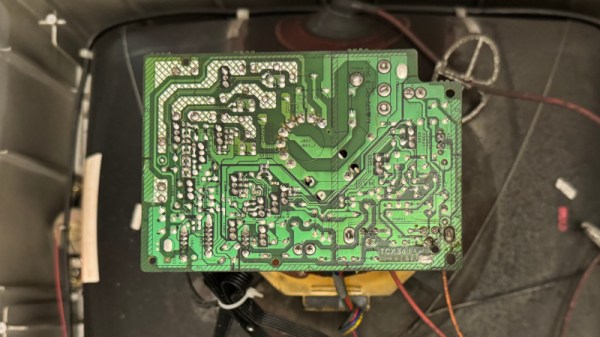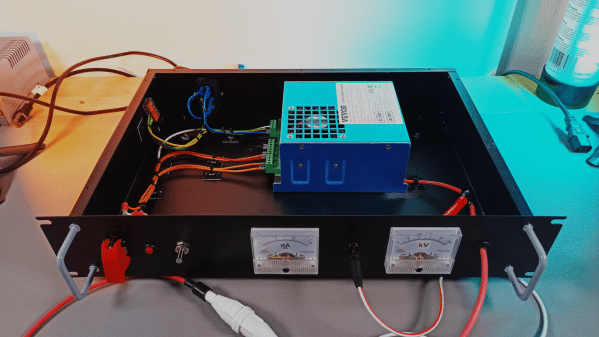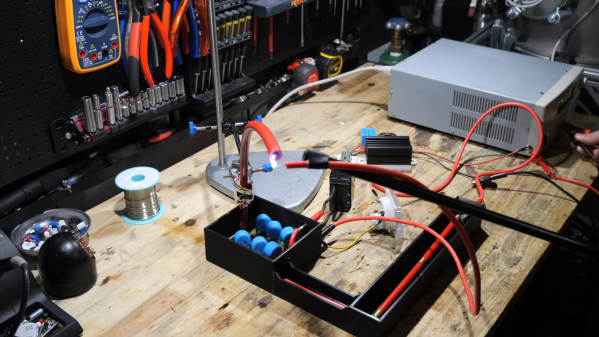Older consumer electronic devices follow a desirability curve in which after they fall from favour they can’t be given away. But as they become rarer, they reach a point at which everyone wants them. Then, they can’t be had for love nor money. CRT TVs are now in the first stage, they’re bulky and lower-definition than modern sets, and thus thrift stores and dumpsters still have them in reasonable numbers. To retrogamers and other enthusiasts, this can be a bonanza, and when he saw a high-end late-model JVC on the sidewalk [Chris Person] wasted no time in snapping it up. It worked, but there were a few picture issues, so he set about fixing it.
high voltage232 Articles
Electrospinning Artificial Heart Valves
When you think about additive manufacturing, thoughts naturally turn to that hot-glue squirting CNC machine sitting on your bench and squeezing whatever plastic doodad you need. But 3D printing isn’t the only way to build polymer structures, as [Riley] shows us with this fascinating attempt to create electrospun heart valves.
Now, you may never have heard of electrospinning, but we’ll venture a guess that as soon as you see what it entails, you’ll have a “Why didn’t I think of that?” moment. As [Riley] explains, electrospinning uses an electric field to build structures from fine threads of liquid polymer solution — he uses polycaprolactone (PCL), a biodegradable polyester we’ve seen used in other medical applications, which he dissolves in acetone. He loads it into a syringe, attaches the positive terminal of a high-voltage power supply to the hypodermic needle, and the negative terminal to a sheet of aluminum foil. The charge turns the PCL droplets into fine threads that accumulate on the foil; once the solvent flashes off, what’s left is a gossamer layer of non-woven plastic fabric.
To explore the uses of this material, [Riley] chose to make an artificial heart valve. This required a 3D-printed framework with three prongs, painted with conductive paint. He tried a few variations on the design before settling on a two-piece armature affixed to a rotating shaft. The PCL accumulates on the form, creating a one-piece structure that can be gingerly slipped off thanks to a little silicon grease used as a release agent.
The results are pretty impressive. The structure bears a strong resemblance to an artificial tricuspid heart valve, with three delicate leaves suspended between the upright prongs. It’s just a proof of concept, of course, but it’s a great demonstration of the potential of electrospinning, as well as an eye-opening look at what else additive manufacturing has to offer.
High-Voltage Fun With An Inexpensive Power Supply
It used to be that nearly every home had at least one decent high-voltage power supply. Of course, it was dedicated to accelerating electrons and slamming them into phosphors so we could bathe ourselves in X-rays (not really) while watching Howdy Doody. These days the trusty tube has been replaced with LEDs and liquid crystals, which is a shame because there’s so much fun to be had with tens of thousands of volts at your disposal.
That’s the impetus behind this inexpensive high-voltage power supply by [Sebastian] over at Baltic Labs. The heavy lifting for this build is done by a commercially available power supply for a 50-watt CO2 laser tube, manufactured — or at least branded — by VEVOR, a company that seems intent on becoming the “Harbor Freight of everything.” It’s a bold choice given the brand’s somewhat questionable reputation for quality, but the build quality on the supply seems decent, at least from the outside. [Sebastian] mounted the supply inside a rack-mount case, as one does, and provided some basic controls, including the obligatory scary-looking toggle switch with safety cover. A pair of ammeters show current and voltage, the latter with the help of a high-voltage resistor rated at 1 gigaohm (!). The high-voltage feedthrough on the front panel is a little dodgy — a simple rubber grommet — but along with the insulation on the high-voltage output lead, it seems to be enough.
The power supply’s 30 kV output is plenty for [Sebastian]’s current needs, which from the video below appear to mainly include spark gap experiments. He does mention that 50 kV commercial supplies are available too, but it would be tough to do that for the $150 or so he spent on this one. There are other ways to go, of course — [Niklas] over at Advanced Tinkering recently shared his design for a more scratch-built high-voltage supply that’s pretty cool too. Whatever you do, though, be careful; we’ve been bitten by a 50 kV flyback supply before and it’s no joke.
Continue reading “High-Voltage Fun With An Inexpensive Power Supply”
Harvesting Electricity From High-Voltage Transmission Lines Using Fences
When you have a bunch of 230 kV transmission lines running over your property, why not use them for some scientific experiments? This is where the [Double M Innovations] YouTube channel comes into play, including a recent video where the idea of harvesting electricity from HV transmission lines using regular fences is put to an initial test.
![The nearly final measurement by [Double M Innovations].](https://hackaday.com/wp-content/uploads/2024/01/hv_transmission_line_energy_harvesting_final_count.jpg?w=400)
As for the results, they were rather concerning and flashy, with the 1000 VAC-rated multimeter going out of range on the AC side of the bridge rectifier, and the capacitor slowly charging up to 1000 V before the experiment was stopped.
Based on the capacity of the capacitor and the final measured voltage of 907 VDC, roughly 36.2 Joule would have been collected, giving some idea of the power one could collect from a few kilometers of fencing wire underneath such HV lines, and why you probably want to ground them if energy collecting is not your focus.
As for whether storing the power inductively coupled on fence wire can be legally used is probably something best discussed with your local energy company.
Continue reading “Harvesting Electricity From High-Voltage Transmission Lines Using Fences”
An Adjustable High-Voltage Power Supply Built With Safety In Mind
It’s not entirely clear why [Advanced Tinkering] needs a 50,000-volt power supply, but given the amount of work he put into this one, we’re going to guess it will be something interesting.
The stated specs for this power supply are pretty simple: a power supply that can be adjusted between 20kV and 50kV. The unstated spec is just as important: don’t kill yourself or anyone else in the process. To that end, [Advanced] put much effort into making things as safe as possible. The basic architecture of the supply is pretty straightforward, with a ZVS driver and an AC flyback transformer. Powered by a 24-volt DC supply and an adjustable DC-DC converter, that setup alone yields something around 20kV — not too shabby, but still far short of the spec. The final push to the final voltage is thanks to a three-stage Cockcroft-Walton multiplier made with satisfyingly chunky capacitors and diodes. To ensure everything stays safe in the high-voltage stage, he took the precaution of potting everything in epoxy. Good thing, too; tests before potting showed arcing in the CW multiplier despite large isolation slots in the PCB.
Aside from the potting, some really interesting details went into this build, especially on the high-voltage side. The 3D-printed and epoxy-filled HV connector is pretty cool, as is the special wire needed to keep arcs at bay. The whole build is nicely detailed, too, with care taken to bond each panel of the rack-mount case to a common ground point.
It’s a nice build, and we can’t wait to see what [Advanced Tinkering] does with it. In the meantime, if you want to get up to speed on handling high voltage safely, check out our HV primer.
Continue reading “An Adjustable High-Voltage Power Supply Built With Safety In Mind”
Powering A Cavity Magnetron, From A Battery
While vacuum electronic devices have largely been superseded over much of consumer electronics, there’s one place where they can still be found for now. The cavity magnetron is a power RF oscillator device in which electrons are induced to move in a circular path through a tuned cavity, inducing a high-power RF field, and it lies at the heart of a domestic microwave oven. They usually need a high-voltage mains transformer and a rectifier to work, but [Hyperspace Pirate] has managed to make a solid-state power supply to power one from a 12 volt battery. Better still, he’s put the resulting combo in a Care Bears lunchbox. Take a look at the video below the break.
The video starts with a potted history of the magnetron before looking at the circuit of a typical oven, which uses a single diode and a capacitor in a simple voltage multiplier. The capacitor value is adjusted to lower the power output, and a pretty thorough job is done of characterising the circuit.
The low-voltage supply starts with an XVS inverter to make the high voltage via another multiplier, but the interesting part comes with the magnetron’s heater. It’s designed for 50 or 60Hz household electricity, but there it’s receiving 40 kHz and has an appreciable impedance. The addition of a capacitor soon restores it to a reasonable performance.
In case you noticed that the ZVS converter might be improved upon, take a look at a flyback converter. Meanwhile, we should probably echo the safety message in the video that playing with magnetrons and their associated transformers can be a nasty way to die. Please take care out there!
Continue reading “Powering A Cavity Magnetron, From A Battery”
Tattoo-Removal Laser Brought Out Of Retirement For A Megawatt Of Fun
We’ve got to say that [Les Wright] has the most fun on the internet, at least in terms of megawatts per dollar. Just look at his new video where he turns a $30 eBay tattoo-removal laser into a benchtop beast.
The junk laser in question is a neodymium:YAG pulse laser that clearly has seen better days, both externally and internally. The original pistol-grip enclosure was essentially falling apart, but was superfluous to [Les]’ plans for the laser. Things were better inside the business end of the gun, at least in terms of having all the pieces in place, but the teardown still revealed issues. Chief among these was the gunk and grunge that had accumulated on the laser rod and the flash tube — [Les] blamed this on the previous owner’s use of tap water for cooling rather than deionized water. It was nothing a little elbow grease couldn’t take care of, though. Especially since the rest of the laser bits seemed in good shape, including the chromium:YAG Q-switch, which allows the lasing medium to build up a huge pulse of photons before releasing them in one gigantic pulse.
Cleaned up and with a few special modifications of his own, including a custom high-voltage power supply, [Les]’ laser was ready for tests. The results are impressive; peak optical power is just over a megawatt, which is enough power to have some real fun. We’ll be keen to see what he does with this laser — maybe blasting apart a CCD camera?
Continue reading “Tattoo-Removal Laser Brought Out Of Retirement For A Megawatt Of Fun”

















